In recent years, the manufacturing industry has been undergoing a significant transformation through the adoption of advanced technologies such as artificial intelligence (AI). One of the most promising applications of AI in manufacturing is predictive maintenance, which involves using data and algorithms to predict when equipment is likely to fail so that maintenance can be performed proactively. This approach offers several advantages over traditional reactive maintenance practices, including reduced downtime, lower maintenance costs, and improved overall equipment efficiency.
AI-powered predictive maintenance in manufacturing involves the use of machine learning algorithms to analyze data from sensors, equipment, and other sources to predict when maintenance is needed. These algorithms can detect patterns and anomalies in the data that indicate potential equipment failures, allowing maintenance teams to take action before a breakdown occurs. By taking a proactive approach to maintenance, manufacturers can avoid costly unplanned downtime and ensure that equipment operates at peak performance.
There are several key components of AI-powered predictive maintenance in manufacturing:
1. Data collection: In order to effectively predict equipment failures, manufacturers must collect data from a variety of sources, including sensors, equipment logs, and maintenance records. This data is then fed into machine learning algorithms that can analyze it and identify patterns that indicate potential issues.
2. Machine learning algorithms: Machine learning algorithms are at the heart of AI-powered predictive maintenance. These algorithms are trained on historical data to learn patterns and relationships between variables that can indicate equipment failures. By continuously analyzing new data, these algorithms can make predictions about when maintenance is needed with a high degree of accuracy.
3. Predictive analytics: Once the machine learning algorithms have analyzed the data and made predictions about equipment failures, manufacturers can use predictive analytics tools to visualize the results and make informed decisions about when and how to perform maintenance. These tools can help maintenance teams prioritize tasks, optimize schedules, and allocate resources more effectively.
4. Integration with maintenance systems: In order to be effective, AI-powered predictive maintenance systems must be integrated with existing maintenance management systems. This allows maintenance teams to seamlessly incorporate predictive maintenance predictions into their workflows and schedule maintenance tasks accordingly.
The benefits of AI-powered predictive maintenance in manufacturing are numerous. Some of the key advantages include:
1. Reduced downtime: By predicting equipment failures before they occur, manufacturers can perform maintenance proactively and avoid costly unplanned downtime. This can help improve overall equipment efficiency and productivity.
2. Lower maintenance costs: Proactively addressing equipment issues can help manufacturers reduce maintenance costs by avoiding expensive repairs and minimizing the need for emergency maintenance.
3. Improved equipment efficiency: By maintaining equipment in optimal condition, manufacturers can ensure that it operates at peak performance, leading to higher quality products and increased production output.
4. Enhanced safety: Predictive maintenance can also help improve workplace safety by reducing the risk of accidents and equipment failures that can cause injury to workers.
5. Better decision-making: AI-powered predictive maintenance provides manufacturers with valuable insights into the health of their equipment and the factors that contribute to failures. This information can help them make more informed decisions about maintenance strategies and resource allocation.
In addition to these benefits, AI-powered predictive maintenance in manufacturing also has the potential to transform the way that maintenance is performed. By leveraging the power of AI and machine learning, manufacturers can move away from traditional reactive maintenance practices and adopt a more proactive and data-driven approach to maintenance.
FAQs:
Q: How is AI-powered predictive maintenance different from traditional maintenance practices?
A: Traditional maintenance practices typically involve performing maintenance on a schedule or in response to a breakdown. AI-powered predictive maintenance, on the other hand, uses data and machine learning algorithms to predict when maintenance is needed before a breakdown occurs. This proactive approach can help manufacturers avoid costly downtime and minimize maintenance costs.
Q: What types of equipment can benefit from AI-powered predictive maintenance?
A: AI-powered predictive maintenance can be applied to a wide range of equipment in manufacturing, including production machinery, conveyors, robotics, and HVAC systems. By analyzing data from sensors and other sources, manufacturers can predict when maintenance is needed and take action to prevent equipment failures.
Q: How accurate are the predictions made by AI-powered predictive maintenance systems?
A: The accuracy of predictions made by AI-powered predictive maintenance systems can vary depending on the quality of the data and the performance of the machine learning algorithms. In general, these systems can achieve high levels of accuracy in predicting equipment failures, helping manufacturers avoid costly downtime and improve overall equipment efficiency.
Q: What are some challenges associated with implementing AI-powered predictive maintenance in manufacturing?
A: One of the main challenges of implementing AI-powered predictive maintenance in manufacturing is ensuring that the necessary data is available and of high quality. Manufacturers may also face challenges in integrating predictive maintenance systems with existing maintenance management systems and in training maintenance teams to use these new technologies effectively.
In conclusion, AI-powered predictive maintenance has the potential to revolutionize maintenance practices in manufacturing by enabling manufacturers to predict equipment failures before they occur and take proactive action to prevent downtime and reduce maintenance costs. By leveraging the power of AI and machine learning, manufacturers can improve equipment efficiency, enhance workplace safety, and make more informed decisions about maintenance strategies. As the technology continues to evolve, we can expect to see even greater advancements in predictive maintenance that will further drive improvements in manufacturing efficiency and productivity.

